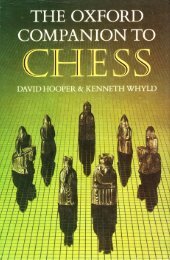Create successful ePaper yourself
Turn your PDF publications into a flip-book with our unique Google optimized e-Paper software.
386 ZINNOWITZVARIATION<br />
A nadcap zigzag <strong>by</strong> RDIM lhat aoo secood prize in<br />
the le.rr.ra., <strong>to</strong>urney, lqj3. White moves lirn<br />
and lorces Black ro give checlmare. Thc key. I<br />
Rc4. leads <strong>to</strong> ibree echo rariatio.s.<br />
1 . . R\b5 2 Rc4 Nxe4 3 a3 4 Qc3 Nxc3<br />
1 . . N{c.1& Nxe3 2 Rb4 Rxb,l+ 3 Ka3 4<br />
1...Nxb5 2Ka5 3a4 4Oa3Nxa3&Nxc4.<br />
Aier . . . Nxc4 in this last va.ialion Black was<br />
unable ro conrnruc capturins (. . . Nxe3)i some<br />
iudges wonld.onsider this a blenish.<br />
ZINNOWITZ VARIATION, 20,1 in the Krlc s<br />
rNDr^N DEEEN.E, used <strong>by</strong> MALT.H at the zinno*ilz<br />
ZNOSXO.BOROVSKY. ET]CENE ALEXAN<br />
DRoVICH 088L1954), Russian born pro<br />
lessional player, nrusic and dramacritic. Hc made<br />
hh <strong>chess</strong> d€but <strong>by</strong> winnins a local louroamentat St<br />
Petersburg 1902 3. Ilclween then and 1914 he<br />
began his sriline career. editing sone leading<br />
R!$ian ches colunns. and phycd in tnrcc<br />
internarional <strong>to</strong>u.nadenlsi hc also played in lour<br />
All Russia (national ch<strong>amp</strong>ionship) <strong>to</strong>umanenrs<br />
and inoneof them, t-6di 1907 {,sharedthirdprizc<br />
NNh SALNE atleT RUBINSDIN and AI-ATIN, AIIeT<br />
seuling in Paris around 1920 Znosko-Borovsky<br />
playcd in rvo major events (London 1922 and<br />
Budapest 1926) and in nany ninor c,cnts, maioly<br />
in Fr.nce and England. notablyNinning ahead oI<br />
raRrA(owrR and LrLrLNlt^L al Paris 1930. Be<br />
tseen the rwo World Wars he *rore several hooksl<br />
they are largely outnoded but then suitability for<br />
club players ol thlt tnnc and the fluent (yle ol his<br />
wriring madc the books borh popular and Fro<br />
firable. and they were published in scvcral languages.<br />
A nan ol principlc and a sPorling<br />
opponenr, he bccamc widely known and liked.<br />
ZOLLNER GAMBIT, 2?9. an enrerpnsing attick<br />
againsl $e DMcoN vARAroN ol the srctr.rAN<br />
DEFENC. anaiysed in thc cany 1940s <strong>by</strong> Hans<br />
ZollDer Nho died <strong>to</strong>Nards lhe end oI the Second<br />
World War while seNing in lhe Ge.nan Amt.<br />
ZONAI IOITRNAMENT, lhe preliminary qual<br />
ilyine event fo. lhe world chanpionship. FIDE<br />
dilides the world inlo geograpnical zoncs and<br />
nany zoDalsr arc hcld concurently <strong>to</strong> delermine<br />
$ho should play in the rNrERz<br />
<strong>The</strong> srenglh ot zonal burnlments varies considerably.<br />
From a wcak zonc only lhe winoer<br />
qould qualify. Ooe ofthe slrongest such <strong>to</strong>uma<br />
menls was a caleeory 15 2onal in the ussR 1964<br />
{on <strong>by</strong> spAss( ahead of BRoNsrErN. srrrN.<br />
(no,.{rovj rcRcnNor, suErNi and GuLLR.<br />
ZUGZWANC, a Ceman Nord .ow anglicizcd lor<br />
a position in which each player would obtain a<br />
worse result il il were his lum <strong>to</strong> nole than ifil<br />
xere not (some authondes call this a ieciprocal<br />
zugzwang.) All <strong>chess</strong> posilioos may beclassifed in<br />
onc of thrcc groups a.cording <strong>to</strong> thei. time<br />
charactedstics. <strong>The</strong>re a.e those, the great nijor<br />
ny, in vhich borh playere sould like 10 have the<br />
molei sou.Ez.s. Nhcn neithcr player ilants io<br />
have rhe nrove bul one piayer can lose the nole<br />
there<strong>by</strong> gainilg advant.ge: and zugzNangs wheo<br />
nenher player wan h 10 have rhc movc but ncithcr<br />
%'&<br />
w<br />
,&<br />
w<br />
ww<br />
"tg*,<br />
%w.<br />
w<br />
%.<br />
Thh position is . zugzsang. Whjte lo play di.Ns<br />
because he nust losc his pa*n or gile stalematel<br />
Blact <strong>to</strong> play loses because rhe pawn can then be<br />
promotcd. This exanple shows thc cha.acterislid<br />
of all zuezwangs: tbe resultcacb playerobtains iiil<br />
vere his tuin ro play is wo$e lhan ilit were nol.<br />
nenher playcr can lose lhe nove, and.cilbercan<br />
nakc rhrears. Apliyercanoiten Dse a zugean8 <strong>to</strong><br />
hn rd\anraEC rt he rcr it corrinE <strong>The</strong> po\irion<br />
qh(e (rng at d5 wh cpdrnarcb,blackktnAatcT<br />
h draNn. Black <strong>to</strong> play puls Whitc in zugzwaog I<br />
. . . Kcs (l . . KdS sould losc) 2 Kd6 Kd8 and this<br />
zug angwillprobablylead<strong>to</strong>lhezuSzwangoltnc<br />
diagiad, e,g. 3 c7+ Kc8. <strong>The</strong> same reslh soutd<br />
<strong>to</strong>llow iI Whire sere loplayRrst. c.g.1K.5 Kcs 2<br />
zugzwangs occur only in lhe end8ane, 6osl<br />
-frequedlly in pawn cndings, occasionally in endings<br />
vith knights. and rarely in endgamcs wilh<br />
linc-picces. <strong>The</strong> nunber ol possiblc zugzwangs is<br />
nnire. For exanple, thcrc are only lour basic kinds<br />
in lhe ending K+P v. K. Many zugzvangs arc<br />
pubtished in books and a player nccds <strong>to</strong> know<br />
rhem. lor he would find some of lhem diffrcuh <strong>to</strong><br />
discovei for himsclf. For ex<strong>amp</strong>le, the position<br />
white Kll. Oc6, BlackKd4.Rt4.If2isazugzsang<br />
that lcw masteB would recognizc unless lhey had<br />
advance knowledee. Black <strong>to</strong> play loses ( 1 . . . RB<br />
2Q84+ Ke3 3 Oc4 Rr4 4Qd5RB sOe5+)but<br />
White <strong>to</strong> play can onty diaw, e.g. I Od6+ Ke/l 2<br />
oe6+ Kl3 3 Qe2+ Kg3 4 Ons Rg4 5 Qe5+<br />
Rf,l 6Qg5+ Kh3 and White is again in zuezwang,<br />
lsee opRrsroN and coNrucaE sauARrslorsome<br />
cx<strong>amp</strong>les in Rhich one sidc may be held in<br />
zuezw nglorselcral movesoreveninPerPeluity.)<br />
A conposer. dcs.ribing a p.oblem position in<br />
which white makes no rhreats (using this word ii<br />
ils problem sensel, nay cal i1a zugzNang. To a<br />
phyer n is nothing ol the sor1, and <strong>to</strong> aroid<br />
confusion n should be callcd a BLo.K.




